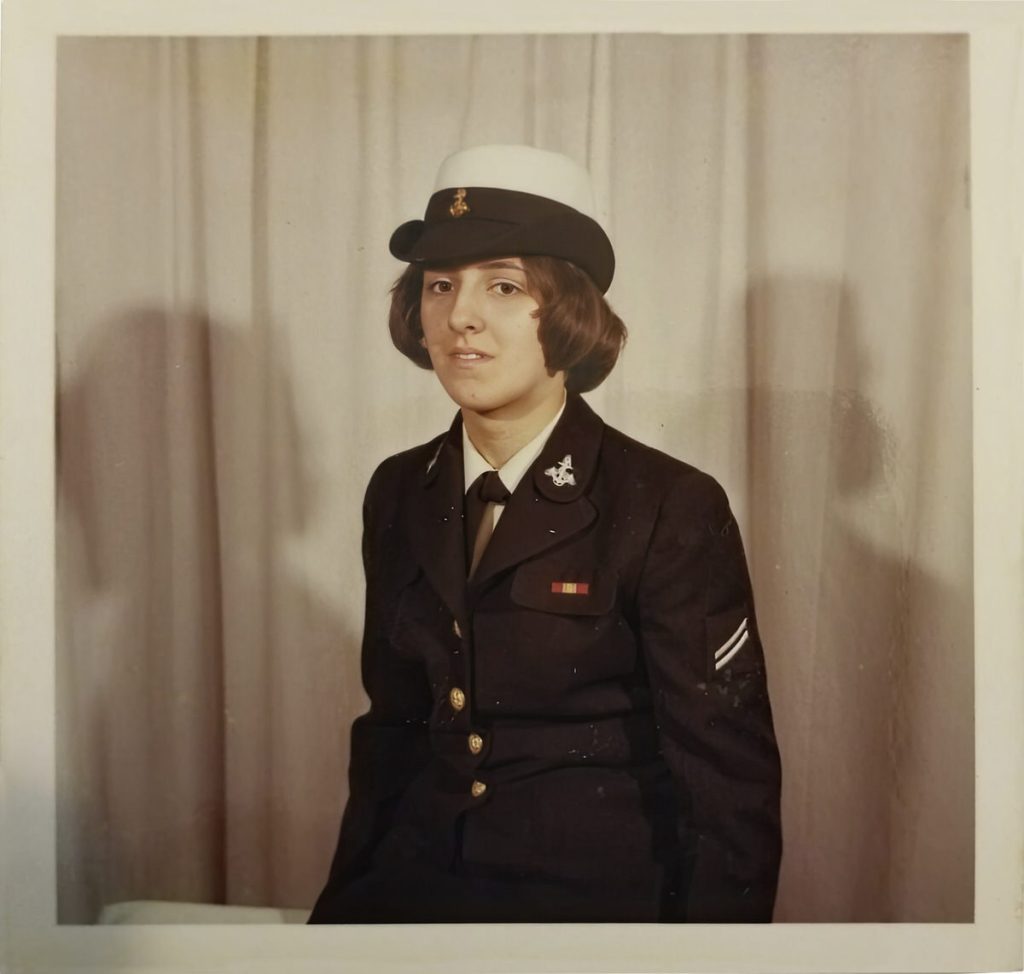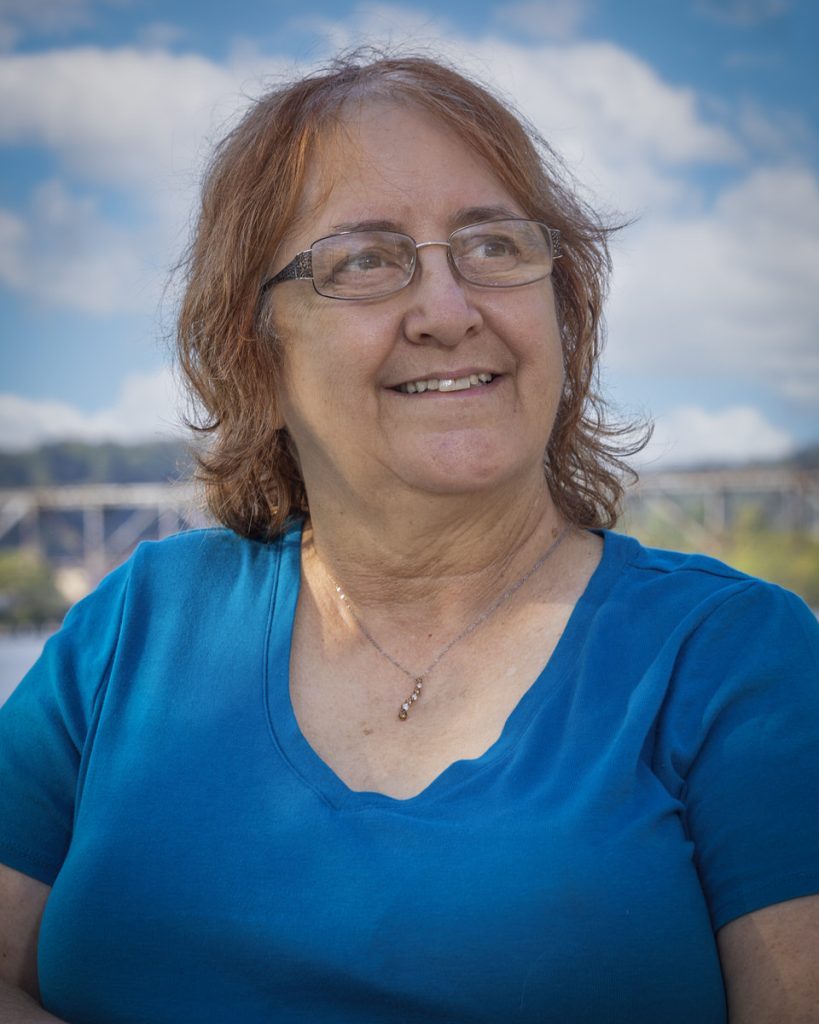Knoxville’s Gail Wallace Davenport helped pioneer women’s Navy service on the high seas
As Gail Wallace looked out over the Panama Canal in late 1973, she was reflecting on more than just the engineering marvel of locks and canals that was enabling the USS Sanctuary to navigate this shortcut from the Atlantic to the Pacific. That was a sight to behold, but as one of the first 60 female sailors to serve on a Navy vessel in non-medical roles as part of a cutting-edge pilot program, Gail had more on her mind. “I knew we were making history,” she recalls today, “and it felt awesome, wonderful to be one of the pioneers.”
When she had received her orders to serve on the ship the previous fall, Gail had jumped at the opportunity. “Oh yes, it was ‘Bring it on, let’s do this!’” she says of the chance to expand women’s roles and responsibilities at sea. Her two-plus years serving on the ship during the Vietnam
era also represented a coming-of-age for Gail, a part of the growing out of her shell that had begun when she first joined the Navy in 1971 after a mostly quiet Midwestern upbringing—one whose influences all but guaranteed she would someday don a uniform and report for duty.
Destined for Service
Born August 7, 1953, in the rural hamlet of Winchester, Illinois, a four-hour drive from Chicago, Gail Wallace was the fifth of nine siblings: five boys and four girls. “It was a pure farm town,” she recalls, “with four blocks total and not one stoplight even to this day. We walked everywhere, and everyone knew each other. It was an ideal place to grow up.”
Among her siblings, six served in the military, spanning the Air Force, Army, and Navy. Her father (World War II and Korea) and a grandfather (World War I) had also served in the Army. “My dad, Warren Wallace, was sent to Oak Ridge to help build the bomb,” Gail says.

She graduated from Winchester High in 1971. Money was tight, college not a viable path, and in those days it was less common for high school grads to live at home with their parents. The message was “Go find your way in life,” Gail recalls. Inspired by her older siblings, especially a brother who had received three purple hearts and two silver stars for his Air Force service in Vietnam, Gail opted to enlist. “But it wasn’t that I felt like I had to,” she clarifies. “I really wanted to serve my country. All of us did. I looked forward to it.”
The Navy was perhaps a curious choice, though, since at that time women made up only one percent or so of that branch. In fact, the first recruitment center she visited refused to take her. A second office farther from home was more amenable, and Gail enlisted on November 10, 1971.
She reported to United States Naval Training Center Bainbridge in Maryland for basic training, where her female drill sergeant “yelled at me pretty much nonstop for 10 weeks.”
The rules were strict, of course, from an enlistee’s bed getting tossed if a quarter wouldn’t bounce off of it, to the expectation of perfectly placed clothes and personal items. The days consisted of “studying and marching, more studying and more marching,” Gail says.
A poor class grade would result in a weekend pass being revoked—a huge downer for the stir-crazy recruits. “I only missed one weekend, and it was miserable.”
She was eventually sent to Naval Station Norfolk (Virginia), where she worked as a yeoman in an office. Granted top-secret clearance, she was tasked with bringing priority teletype messages to the brass, among other administrative duties.
In mid-1972, word started circulating that the Navy was about to expand the role of women aboard ship, beginning with one specific vessel, the USS Sanctuary.
As a joke with her friends one night at a base’s watering hole, she said, “I’m gonna be one of those girls picked for the ship”—and the very next week, she received orders to report. “I was in shock!”
Women on the Water
The Sanctuary, a hospital ship, had originally been commissioned during World War II. With a capacity
for 70 officers and 498 enlisted sailors, the vessel later earned 12 campaign stars during the Vietnam era, serving on counteroffensives from 1966 to 1971.
After that, the Navy opted to repurpose it, so the ship was recommissioned for humanitarian purposes on November 18, 1972.
According to an article in The Navy Times, Admiral Elmo Zumwalt became Chief of Naval Operations in 1970 with that branch of the service “in turmoil.” Morale was low, Vietnam was unpopular, and calls for expanding women’s rights throughout American society had grown more insistent.
Largely to address those concerns, Zumwalt issued 121 policy missives called “Z-Grams,” one of which, #116, came to be known as “the Navy’s Equal Rights Amendment.”
“Building on Truman’s 1948 Women’s Armed Services Integration Act,” 116 “promised equal rights and opportunities for women in the Navy,” the publication reported. Considered a “radical proposal” at the time, it “included command opportunities . . . opened the Naval Reserve Training Corps to women, and eliminated the segregated service of male and female sailors. For the first time in history, women could serve side-by-side with men at sea (in non-medical capacities).”
As a pilot program growing out of Z-Gram 116, the Sanctuary would incorporate several female officers and 53 female enlisted sailors when it embarked on goodwill medical missions in late 1972. These “first female personnel to serve at sea in a non-medical role” included “machinist’s mates, radiomen, yeomen, dental technicians, boatswain’s mates, hospital corpsmen, and many more. They stood watch and performed naval duties just as their male counterparts did.”
The Sanctuary’s “non-combatant mission” was ideal for testing “a gender-integrated crew,” since the ship already had separate compartments for the Navy Nurse Corps females who had served aboard. The ship was further equipped to accommodate the expanded female population before the pilot program’s first voyage.
One of those first new non-medical female sailors was Gail Wallace.
Bringing Hope and Healing
Working as a yeoman in the administrative area at first, Gail quickly adjusted to life aboard the ship. Her quarters were the same as the men’s: a tight bunk, a tiny compartment for personal items, and a small locker to hang uniforms
Gail was transferred to help run the ship’s expansive store, which provided essential supplies to a population not much smaller than her entire hometown.
The Sanctuary made its way down the Atlantic coast and to South America, where it would dock so Navy doctors and nurses could treat patients in communities that sorely lacked medical services. The vessel and its crews would do the same in Port au Prince, Haiti, among other locales.
Gail considered the ship “a big family” and loved inter- acting with her fellow sailors, male and female alike. For the most part, the men were welcoming. “They accepted and respected us, as long as we did our jobs, and saw us as shipmates,” she recalls.
The Sanctuary was slated to go to Vietnam in 1974, where it would treat and transport wounded soldiers, but those orders were canceled, ostensibly because the US was easing down its engagement and looking toward the end of combat operations in Southeast Asia. There also were plans to navigate to Greece, but that plan was scuttled.
Guided ‘Home’ to Knoxville
When her stint on the ship ended and she was discharged from the Navy in November 1974, Gail returned to Illinois. She gravitated toward secretarial work that would later include an opportunity for a role at UT-Knoxville.
In the end, “it was God’s will” that propelled her to migrate south from Illinois, she says. “A group from Knoxville had come to stay with us at our church.”

Connecting with them, along with meeting a Maryville family that would later take her in, were among the circumstances that aligned and made East Tennessee the right place for Gail beginning in the early 1980s, when she began to put down roots that run deep to this day.
Patriotism continued to flow through her veins, so it’s only natural that she served seven years in the Army Reserves via the 844th engineering battalion out of Knoxville.
“I loved it, and I took it seriously,” says Gail, who rose to the rank of Sergeant (E5). She received several medals during her service, which focused on water purification initiatives. Her work took her mostly to Fort Bragg, North Carolina, and also into Alabama.
It’s also fitting that Gail looked for opportunities to continue breaking down barriers. “When we hit the time for our first two-week camp [in the Reserves], they said they wouldn’t make us camp because we were women. I said no thank you, we’ll do everything that the men are asked to do.”
In Knoxville she met and wed Stephen Davenport, and they were married for 32 years until his passing 13 years ago. Gail is the mother of “two wonderful sons,” Michael and Matthew, both of whom are married, and is happy to report that, “Finally, I have one grandson who is almost 2. He calls me ‘Ma.’”
Gail lives on Western Avenue, “in the middle of every- thing,” and enjoys the vibrancy of the community. The Knoxville area appeals to her on many levels, including its support for the military and veterans.
“I had lived in Virginia, California, Florida, New York, and Illinois, and I haven’t found any place where people are friendlier than they are here. The whole city is wonderful.”
Between her sons and grandson, her crafting community, church, clubs, and volunteering with veterans’ organizations, Gail stays blissfully occupied.
Last April, she was part on an HonorAir Knoxville flight to Washington, DC. One of the reasons she applied for the trip was to memorialize two men from her rural hometown in Illinois, James H. Price and David R. Hunt, who died in combat in Vietnam. “I found their names on the wall and brought back etchings that I’m going to take to the museum in Winchester,” Gail says.
Reflecting on her own time in the Navy, she says, “I may speak for a lot of people in that I served because I wanted to. I love our country, and I’m proud of what we accomplished. If I could have served for 80 more years, I would have gladly done it.”

Comments are closed.